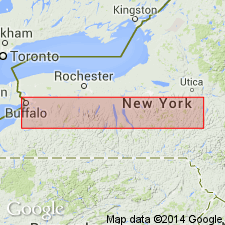
- Usage in publication:
-
- Colgate member
- Modifications:
-
- Original reference
- Biostratigraphic dating
- Dominant lithology:
-
- Sandstone
- Shale
- AAPG geologic province:
-
- Adirondack uplift
Summary:
Pg. 219, 221, etc. Colgate member of Skaneateles formation; [Colgate member of Skaneateles shale]. Fine-grained, thin-bedded, cross-bedded sandstone and bluish gray arenaceous shale exposed on campus of Colgate University, Hamilton, [central New York]. Stratigraphically it lies at top of Berwyn member and is transitional with it. Upper part consists of 20 feet of coarse arenaceous shale capped by 1.5 feet of crinoidal limestone containing SPIRIFER DIVARICATUS, which is characteristic of Centerfield limestone, basal member of overlying Ludlowville formation. Best exposures of this upper shale are at top of University Quarry and in falls and quarry behind the buildings of Hatch's Red Gate stock farm. The Colgate is not known west of eastern margin of Cazenovia quadrangle, and east of type section it was but imperfectly identified in upper part of Gould's gully, Unadilla Valley, where the upper shale has disappeared. But the member is prominent in Chenango Valley and is noted for its fine fossils. [Although this member is included in Skaneateles formation, diagram on p. 219 shows it to be eastern equivalent of Centerfield limestone member of Ludlowville formation. Age is Middle Devonian.]
Source: US geologic names lexicon (USGS Bull. 896, p. 489).
For more information, please contact Nancy Stamm, Geologic Names Committee Secretary.
Asterisk (*) indicates published by U.S. Geological Survey authors.
"No current usage" (†) implies that a name has been abandoned or has fallen into disuse. Former usage and, if known, replacement name given in parentheses ( ).
Slash (/) indicates name conflicts with nomenclatural guidelines (CSN, 1933; ACSN, 1961, 1970; NACSN, 1983, 2005, 2021). May be explained within brackets ([ ]).

